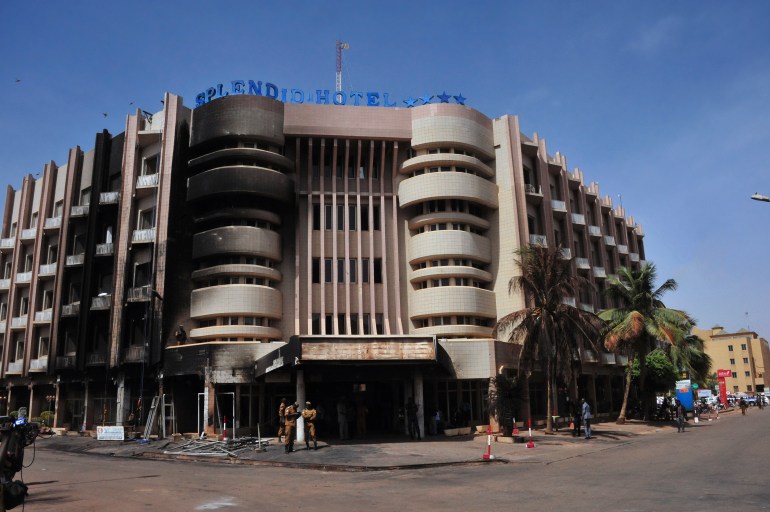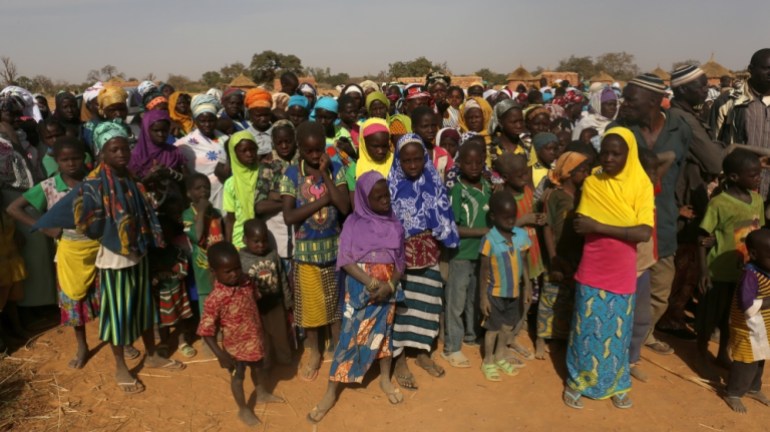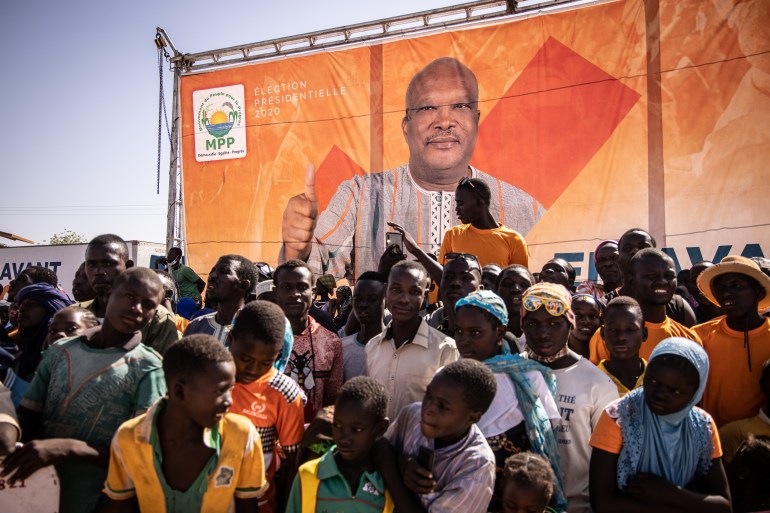How has Burkina Faso changed since the ‘insurrection’?
Burkinabes go to the polls on Sunday as the conflict-hit country faces an escalating humanitarian and economic crisis.

On October 30, 2014, Serge Bambara, better known as Smockey, a popular Burkinabe hip-hop artist, stood and watched as the country’s national assembly building was burned and looted by protesters.
The demonstrators, who had for days taken to the streets of the capital, Ouagadougou, were angry at longtime President Blaise Compaore’s attempt to extend his 27-year rule by amending the constitution.
Keep reading
list of 4 itemsBurkina Faso: 13 dead as days of heavy rains cause floods
Surrounded by war, Burkinabe civilians have votes taken away
Attackers kill 25 displaced civilians in Burkina Faso, UN says
A leading figure in the uprising, Bambara had pleaded with the crowd not to set fire to public buildings. Nonetheless, as the flames engulfed Parliament, it marked a turning point in Burkina Faso’s history and the end of Compaore’s authoritarian rule.
Bambara said protesters’ demands included presidents to stand down after two terms, freedom of expression and better living conditions, as well as justice for the murders of former president and national hero Thomas Sankara in 1987 and of investigative journalist Norbert Zongo in 1998, two of the best known cases associated with Compaore’s rule.
Six years on, Bambara says Burkina Faso’s democratically elected government, led by President Roch Marc Kabore, “has been left behind by the expectations of the people … We really had the right to expect better.”
As Burkinabes go to the polls on Sunday, potentially to elect Kabore for a second term, the country stands at a crossroads.
It is battling a spiralling conflict, humanitarian disaster, COVID-19 and perennially poor living standards.
But, what has led to so many of the aspirations of the uprising, or “the insurrection” as many Burkinabes refer to it, going unfulfilled?
Escalating conflict
In power since 1987, Compaore was only the last in a long line of autocrats to run Burkina Faso. Before him, the last democratically elected leader of the country was Maurice Yameogo, who oversaw independence from France in 1960 and was removed by another uprising six years later.
Five years ago, the return of democracy after an almost half-century hiatus brought with it a sense of hope and optimism for many, especially young, Burkinabes in a country of 20 million, where the average age is 17.6 years.
After an interim government led the transition to democracy in the wake of the insurrection and saw off a military coup which sought to reverse the move to popular rule, Burkina Faso on November 29, 2015 held an election that saw Kabore sweeping to power with 53.5 percent of the vote.
In its early stages, Kabore’s presidency looked set to be defined by ambitious development goals, freedom of expression and a departure from military governance.
Instead, Burkina Faso’s fate has been steered by a conflict that has killed approximately 5,000 people, created one of the world’s fastest growing humanitarian crises and exacerbated many of the societal problems Kabore was seeking to solve.
Data from the Armed Conflict Location and Event Data Project (ACLED), a consultancy which gathers information on conflict globally, shows that in the five years before Kabore came to power, Burkina Faso saw just 55 fatalities related to conflict. In the five years since, there have been 4,939, an increase of 8,880 percent.

The conflict struck right to the heart of the nation in January 2016 when al-Qaeda-linked fighters attacked the Splendid Hotel and Cappuccino restaurant in Ouagadougou, killing 28 and wounding 56, including many foreign nationals.
Catching many Burkinabes and outside observers off-guard, this was a wake-up call for many that decades of peace were at an end in a country which had been known in the region for stability and tolerance.
“What began as an insurgency in an isolated corner of the northern Soum province has grown ever since and swept large swaths of territory,” Heni Nsaibia, an analyst for ACLED, told Al Jazeera.
By 2019, violence had spread from its origins in the north of the country to the east, as well. Burkina Faso has never had a civil war, but Nsaibia says the current conflict has many of the key characteristics of one.
The fighting has its origins in neighbouring Mali where armed groups such as Jama’at Nasr al-Islam wal Muslimin (JNIM) and Islamic State in the Greater Sahara (ISGS), linked to al-Qaeda and ISIL respectively, took over large parts of that country from 2012 onwards.
Flown out of the country by a French intelligence service helicopter into exile in neighbouring Ivory Coast, the departure of Compaore after the insurrection was the triggering event which allowed the conflict to spill over the border into Burkina Faso.
Discontent in the remote provinces where rebels now roam free, had been simmering for years, however. Compaore was long suspected of having a pact with Malian rebels whereby he allowed them safe haven in Burkina Faso in exchange for non-aggression – but that came to an end when he left power.
Aside from the Malian groups, Malam Ibrahim Dicko, a Muslim preacher and radio host, founded Burkina Faso’s own homegrown rebel group, Ansar ul Islam, in late 2016.
Together, these groups have shaken the social fabric of Burkina Faso to its core, influencing many aspects of public behaviour, government policy and tearing lives apart.
“In the last two years, [Burkina Faso has] replaced Mali as the epicentre of armed attacks attributed to jihadi militant groups,” Nsaibia says.

One million displaced
Aside from the tremendous loss of life brought about by the conflict, perhaps the largest upheaval in Burkina Faso has been the displacement of more than a million people, or five percent of the population.
Last year, some 90 percent of the internally displaced people (IDPs) in the country fled to host communities, according to the United Nations refugee agency, UNHCR. That number has now been flipped upside down, with around 90 percent of IDPs living in segregated camps, which is likely to lead to increased problems with social cohesion in the long term.
“We have IDPs, who were living in peace in their communities, obliged today to live in towns without jobs,” says Arsene Yabre, a history scholar at the Free University of Burkina Faso in Ouagadougou. “That affects public health and the economy.”
Known in the past for its lively cinema and cultural scene, and drawing visitors for its wildlife such as one of the last populations of the West African lion, Burkina Faso in recent years has seen tourism numbers collapse.
NGOs also struggle to access many areas of the country as their security teams are unable to get a handle on where it is safe to distribute aid and where it is not. The UN’s World Food Programme recently said that some parts of Burkina Faso could already be in famine-like conditions because of a lack of humanitarian access.
“At the international level, people are not coming for tourism and NGOs are struggling with implementation because so many areas are marked as red,” Yabre said.
Indeed, maps of Burkina Faso made by diplomats from countries such as the United Kingdom, France and the United States, advising citizens on where it is safe to travel have been progressively turning from green, to orange, to red in recent years, as chunks of the country become no-go areas.
Burkina Faso’s primary export, gold, has also been affected by the fighting. In November last year, fighters in the east of the country attacked buses carrying workers to the Boungou gold mine, owned by the now-defunct Canadian company Semafo, killing at least 37 and wounding many more.
Even with so many implications for the economy wrought by conflict, some of the Kabore government’s best-laid plans have come to fruition. Many Burkinabes believe the government has performed well in improving infrastructure and health.
The number of paved roads in the country has increased by 26.7 percent under Kabore and free healthcare for children up to five years old has also been implemented. However, data from the World Bank shows there has been little progress in raising the country’s gross domestic product.
Any progress made by the government on access to education has effectively been rendered null as more than 350,000 children have been pushed out of schools by the conflict.
Rise of vigilantes
Aside from the emergence of fighters in areas of the country where the rule of law has fallen away, vigilantes have also come forward to fill the vacuum.
The Koglweogos, a group of mostly rural farmers numbering about 40,000, took up arms in 2015. Initially shunned by the government, a new law passed in January allowing for the creation of a civilian defence force has enabled them to be armed and assist the military in its operations.
Another rebel group, the Dozos, made a prominent appearance in the front rows of Kabore’s first campaign rally earlier this month, further indicating the government has essentially handed over part of the state’s monopoly on the use of force.
“State-sanctioned violence has increased at the hands of government forces and state-backed groups including Koglweogo, Dozos, and the most recent creation, the volunteers for the defence of the homeland (VDP),” Nsaibia says.
Human rights groups have accused Koglweogos of carrying out atrocities against civilians, mostly from the nomadic Fulani ethnic group, including the Yirgou massacre, which saw as many as 200 people killed during the 2018-2019 New Year period. State security forces have also been implicated in massacres, such as the killing of 160 people in Djibo this year, according to Human Rights Watch.
The number of dead stemming from violence by state and state-backed forces has now reached similar levels to those killed by rebel and other armed groups.
“The approach of the Kabore regime has been heavy-handed even by subregional standards when comparing the targeting of civilians by government forces in Burkina Faso, Mali and Niger, the three countries primarily concerned by the Sahel crisis,” Nsaibia says, “Overall, the approach appears to have fuelled more than it has reduced militancy.”
As a result of these tactics, Ouagadougou has remained largely unaffected by the conflict in nearly three years. No attacks have occurred in the capital since an attack on the French embassy and a military headquarters in early 2018.
Life broadly carries on as normal, leading to further disparities between citizens who live in the countryside and those in big cities.
The targeting of Fulanis in particular has further compounded the country’s problems with social cohesion.
This week, Al Jazeera interviewed a 21-year-old Fulani man, who declined to be named for fear of reprisals. He said Koglweogos pulled him off a bus at a checkpoint in the east of the country in October last year, after being singled out because of his ethnicity.
“After many questions and harassment, they released us, but it should be noted that there were many Fulanis stopped that day. Days later, I learned that they were all shot by the [Koglweogos]. They have a place they call ‘the Fulani abattoir’ around their village,” he said. His account could not be independently verified.
The man said the rest of his family has already fled the country.
“With security threats, they all left for Ivory Coast. Today, I am the only one of the family left in Burkina Faso.”
Since rebel groups utilise ethnic divisions to recruit new members, analysts say further disenfranchisement of ethnic groups, such as the Fulanis, will play into armed groups’ hands.
“Of course there were existing gaps, but the negative side here is the fact that the Fulani are said to be [the only ones] involved in the terrorists’ attacks … It’s not true because we also see different ethnic groups involved,” says Yabre.

The speed and success of rebel groups in destabilising the country have been striking. Unlike in 2015, when polling took place across the country, this year, the independent electoral commission was unable to hold voter registration in more than 17 percent of the country’s municipalities. Polling will not take place in those areas either, which will no doubt be seen as a victory for the fighters.
Reports this week suggest rebel groups are also intimidating voters and instructing them not to vote.
Burkina Faso’s transition to democracy has been fraught and the insecurity has wrapped tendrils around almost every aspect of society, leaving the government hamstrung, but the country’s leaders are not entirely without blame, according to Yabre.
“Government members are not willing to do what the population wants as should be the case in a democracy where the country is governed by the population … [The transition to democracy] was good but has not been applied properly. You know we are from a culture where the chief is always at the top, but sometimes we need to speak truth to the leaders,” he says.
As for Bambara, he says that although the country has been wracked with conflict since 2015, “the gains of the insurrection are preserved for the moment and this is what matters to us … We must not forget that the ghosts of the past could resurface if we move too fast.”
He says, despite the war, the move to democracy has been a positive one and he is optimistic for the future.
“Young people are starting to get involved in politics and there are more and more independent candidates, which in my opinion bodes well for a real will for change that may already be in motion.”
Whether a will for change can overcome the stifling effect of the conflict remains to be seen.